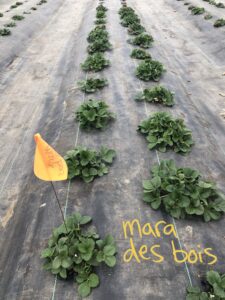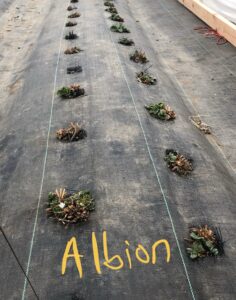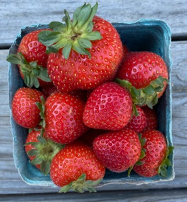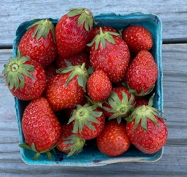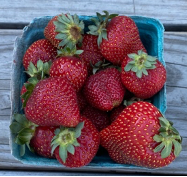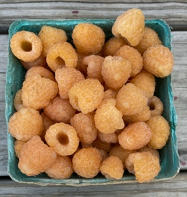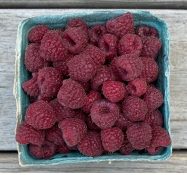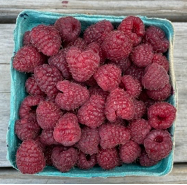Final report for OW18-020
Project Information
Central Oregon’s challenging growing conditions include: 1) a very short growing season (70-100 days); 2) average annual precipitation of ~11 inches; 3) drastic swings in diurnal temperatures; 4) possibility of frost anytime of year; and 5) sandy soils low in organic matter. The USDA plant hardiness zones in Central Oregon range from 3 to 5, with pasture and forages as the traditional crops grown in the area. Despite the challenging growing conditions, there is fresh-market produce grown in Central Oregon, and there is strong demand from the community through farmer markets, CSAs, restaurant buyers, and wholesale accounts. While some vegetables are grown very well in the region, there is almost no fruit being produced in Central Oregon, despite strong demand. Growers report that farmers’ market patrons with federal nutrition assistance benefit vouchers want to use their vouchers to purchase berries.
Raspberries and strawberries are the most suitable berries for Central Oregon due to their cold hardiness, but yield loss due to winter injury and frosts are a major concern. Elsewhere in the US, protected culture has been used to extend the berry growing season and improve yields. In Central Oregon, high tunnels are currently used to grow multiple high-value vegetable crops in one season, so farmers are not likely to plant a perennial crop in a high tunnel unless proven profitable. This project aims to determine whether berry production in Central Oregon is an economically viable enterprise, and if high tunnels are a justified expense to increase profitability and fruit quality.
1. To evaluate raspberry and strawberry production in both protected and unprotected culture systems in Central OR, including berry yield and quality, in order to help growers choose the most successful production systems.
2. To compare multiple cultivars of raspberry and strawberry for suitability to Central OR, including adaptability, berry yield and quality, in order to help growers make cultivar selections for production success.
3. To perform economic evaluation of both protected and unprotected berry production in Central OR, and determine whether protected culture is a justified investment.
4. To observe differences in pest management challenges in protected and unprotected culture.
5. To conduct local, regional and interstate outreach of berry crop research in the high desert through field days, workshops, presentations, and fact sheets.
6. To increase the supply of fresh fruit as a healthy food option for Central OR residents.
Cooperators
- (Researcher)
- (Educator)
- (Researcher)
- (Researcher)
- (Researcher)
- (Researcher)
- (Researcher)
Research
The research portion of this project began in May 2019 when the raspberries and strawberries were planted. The evaluation of berry production systems and varieties was conducted at seven sites across the region using a mother-daughter experimental design. In this design, the mother trial includes all of the possible research treatments, while the daughter trials only include those treatments of interest to each farmer. The mother-daughter experimental design allows farmers to participate in research with fewer financial and labor restrictions, and participants are free to choose the treatments of greatest interest and value to their farm.
The mother trial was managed and evaluated by the PI (Clare Sullivan) and located in Alfalfa, OR (Deschutes County). Six cooperating farms were involved in the study, and each farm hosted a daughter research site. All seven sites were managed organically, and soil amendments were applied based on soil tests and in consultation with the PI.
Mother Trial: Design and Establishment
Two berry trials were established at Windflower Farm in Alfalfa, OR during the spring of 2019. Raspberries and strawberries were planted according to recommended commercial practices. Each trial was arranged using a split-plot design. The main factor was production system ('protected' grown indoor in a high tunnel vs. 'unprotected' grown outdoor in the open field) and the replicated, subplot factor was berry variety (Figure 1). Strawberry subplots were replicated three times, and raspberry subplots were replicated four times. The trials were managed using organic practices. Pre-plant soil test revealed high levels of phosphorus and potassium, and low levels of nitrate-nitrogen, sulfur and calcium. Pre-plant fertility was met with broadcasted poultry manure (30lb N/ac, 24lb P/ac, 16lb K/ac), feather meal (40lb N/ac), gypsum (130lb/ac), and compost (20ton/ac).
Four strawberry varieties were planted as bare rootstock in a quonset-style high tunnel (14x45ft structure, Figure 2) and the open field on May 6, 2019. All of the varieties were cold-hardy and day-neutral types: ‘Albion’, ‘Evie 2’, ‘Mara des Bois’, and ‘Seascape’. Strawberries were planted directly into landscape fabric at 1ft-spacing in double rows, with beds spaced 4ft apart (Figure 2). Individual plot size measured 10ft indoor, and 20ft outdoor. First inflorescences were removed until early June in order for the strawberry plants to get established vegetatively before entering the productive phase. Runners were removed all season to maintain each strawberry plant as one mother plant. Strawberry plots were irrigated using two drip irrigation lines per bed; emitters on the drip lines were at 12" spacing.
Four raspberry varieties were planted as bare rootstock in a separate gothic-style high tunnel (30x45ft structure, Figure 3) and the open field on May 8, 2019. All of the raspberry varieties chosen were cold-hardy and primocane-bearing types: ‘Anne’, ‘Caroline’, ‘Heritage’, ‘Joan J’. Raspberries were planted at 2ft-spacing within rows that were planted 8ft apart (Figure 3), and landscape fabric was used between the rows for weed suppression. Individual plot size measured 10ft indoor, and 15ft outdoor. Trellis systems were installed to support the raspberries once they were tall enough. Raspberry plots were irrigated using one drip line per bed; emitters on the drip lines were at 12" spacing.
Three Hobo weather stations were installed on the research site to measure soil and air temperature: one was placed in the open field, one in the strawberry high tunnel, and one in the raspberry high tunnel.
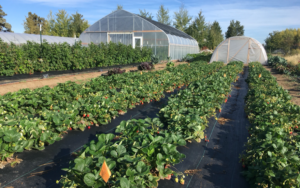

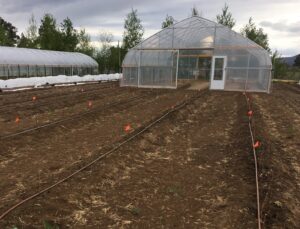
Mother Trial: 2019 Growing Season
In 2019, all plots were fertilized twice over the growing season with liquid fish fertilizer (5-1-1) at a rate of 10gal/ac. Liquid fertilizer was applied to the soil at the base of the plants using a backpack sprayer. Plots were irrigated every other day May through September using drip irrigation lines with 12” emitter spacing. Strawberry plots had two drip lines per bed, and raspberry plots had one drip line per bed. Shade cloth was installed on both of the high tunnels once temperatures were consistently over 85 degrees Fahrenheit to protect the plants.
Berries were harvested once a week when production began, and then twice a week when berries were in full production. Harvested berries were separated into ‘marketable’ and ‘unmarketable’ in order to calculate percent cull. Marketable and unmarketable berries per plot were then counted and weighed to calculate yield per plot and fruit size (gram/berry). In order to compare yield across treatments, marketable weight was normalized per plants. Total marketable yield per treatment was the accumulated yield over the growing season, normalized per plant. Data were subjected to analysis of variance, and treatment means were compared using Tukey’s honest significant difference test (P < 0.05).
Mother Trial: 2019 Post-Harvest and 2020 Growing Season
The green leaves of the strawberry plants were left on plants though the fall of 2019 to contribute to the carbohydrate reserves in the plant. In early February 2020, all dead and green leaves were cut away from the strawberry crowns. New crown growth started in March, and berries were fertigated once the irrigation season started in mid-April. Strawberries continued to be fertigated bi-weekly though the growing season with 5-0-0 liquid fish fertilizer, aiming for a total of 80lb N/ac for the season. Runners were removed once a month in May, June, and July.
Raspberry canes were cut back to ground level in early February 2020 when plants were dormant. Raspberries were fertilized with feather meal at 40lb N/ac before canes emerged, and mulched with yard debris compost. Once raspberry canes emerged, rows were narrowed to 18 inches. At flowering, indoor raspberries received an additional 20lb N/ac with 5-0-0 fish fertilizer. Raspberry rows were narrowed again to 18 inches in mid-July.
Berry harvest and yield measurements in 2020 followed the same protocols outlined for the 2019 growing season.
Daughter Trial Designs
Six farmer collaborators hosted trials with the same berry varieties used in the mother trial and followed similar recommended commercial practices. On-farm trials varied in the size and type of high tunnel, berries grown, and the number of varieties compared. All berries were planted in late April or early May of 2019 and grown for two seasons. Five farms compared protected and unprotected strawberry production; two farms compared protected and unprotected raspberry production; and one farm compared different raspberry varieties grown outdoor (Table 1).
Table 1. Details of the daughter trial sites, including which berry varieties (Var) and growing systems (System) each farm compared.
|
Farm |
Strawberry Comparisons |
Raspberry Comparisons |
Comments |
|
Boundless Farmstead |
Var: Evie 2 & Seascape System: Quonset-style high tunnel vs. outdoor |
N/A |
Overhead irrigation |
|
Rainshadow Organics |
Var: Albion, Mara des Bois, Seascape System: Caterpillar tunnel vs. outdoor |
N/A |
Drip irrigation |
|
Zajac Farms |
Var: Albion Evie 2, Seascape System: Caterpillar tunnel vs. outdoor |
N/A |
Drip irrigation with fertigation |
|
Fields Farm |
Var: Albion, Evie 2, Seascape System: Caterpillar tunnel vs. outdoor |
Var: Caroline, Double Gold, Joan J System: Gothic-style high tunnel vs. outdoor |
Drip irrigation Heavy compost application to raspberries Outdoor plants damaged by deer |
|
Golden Eagle Organics |
Var: Evie 2, Mara des Bois, Seascape System: Quonset-style high tunnel vs. outdoor |
Var: Anne, Caroline, Joan J System: Quonset-style high tunnel vs. outdoor |
Drip irrigation with fertigation Mara des Bois removed after Year 1 of trial |
|
Dome Grown Produce |
N/A |
Varieties: Double Gold, Joan J |
Raspberries outcompeted by grass |
Mother Trial Results - Strawberry
Strawberry Trial, First Year Results (2019)
The first pick of fruit in the establishment year was July 19, 2019 for both indoor and outdoor production, but berry production was not consistent until mid-August (Figure 4&5). Production did increase at a faster rate in the high tunnel than in the open field. Berry yield peaked August 20 for Evie 2, Mara des Bois and Seascape, but Albion production was slower and peaked in September. Rain and cold temperatures in mid-September 2019 resulted in dirty and mushy fruit and a drop in marketable yield (Figure 4&5). Although there was still a lot of fruit left on the plants, freezing temperatures at the end of September/early October ended harvest for both the high tunnel and field (Figure 6).
Overall, total marketable yield in 2019 was significantly higher for indoor production (1 lb/plant) than outdoor production (0.8 lb/plant), but growing season length was only marginally extended in the high tunnel. Evie 2 stood out as the highest yielding variety in the first year of production, followed by Mara des Bois, Seascape, and Albion (Figure 7). Berry production of Evie 2 and Albion increased by more than 40% in the high tunnel compared to the field, while indoor production did not have a significant effect on berry yield for Mara des Bois and Seascape (Table 2).
Strawberry fruit size differed by variety and also by production system in the first year (Table 2). Berries were on average 18% larger for indoor production (13 g/berry) than outdoor production (11 g/berry). Albion and Evie 2 had significantly larger fruit size than Seascape and Mara des Bois (Table 2). Mara des Bois is known to be a smaller berry, and in 2019 it averaged ~50% weight of the other berries. Fruit size is significant for a grower because the larger the berry, the fewer berries needed to fill a pint, resulting in lower labor requirements.
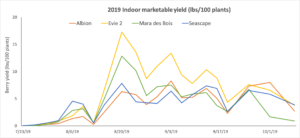
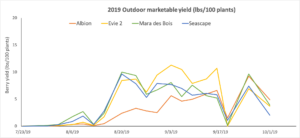
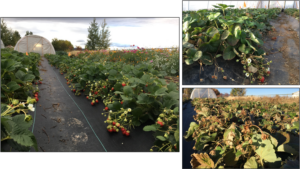

Table 2. First year strawberry data comparing four varieties grown outdoor (field) vs. indoor (high tunnel) in 2019. First fruit was July 19 and harvest ended early October. Data is an average of three replicates.
|
Variety |
Total marketable yield (lbs/plant) |
% Yield increase indoor |
% Cull (by weight)1 |
Average fruit size (g/berry) |
|||
|
|
Field |
Tunnel |
|
Field |
Tunnel |
Field |
Tunnel |
|
Albion |
0.6 b2 |
0.8 b |
44% |
8 |
5 |
14 a2 |
16 a |
|
Evie 2 |
1.0 a |
1.4 a |
46% |
10 |
7 |
13 a |
15 a |
|
Mara des Bois |
0.9 a |
0.9 b |
7% |
10 |
8 |
6 c |
8 c |
|
Seascape |
0.8 a |
0.9 b |
9% |
10 |
5 |
12 b |
13 b |
1 % cull presented only until Sep 16 for 2019 harvest, % cull rose dramatically after Sep 16 due to rain and freeze
2 Results in the same column followed by a different letter are significantly different at P < 0.05
Strawberry Winter Survival and Spring Growth
Winter survival of strawberry plants was determined by comparing September 2019 plant totals to April 2020 plant totals for each variety (Table 3). Overall, plant survival was higher indoor (93%) than outdoor (91%). Mara des Bois had the highest plant survival rate and Albion had the lowest.
Starting in mid-April 2020, weekly vigor rankings were taken for all plots. The four strawberry varieties were ranked relative to the other varieties, and the rankings were recorded for 12 weeks. The vigor rankings remained consistent over that time period: Mara des Bois was the most vigorous variety across all reps in both the indoor and outdoor plantings (Figure 8). Albion was the least vigorous across all reps in both the indoor and outdoor plantings. Seascape and Evie 2 were similar to each other in vigor ranking behind Mara des Bois and ahead of Albion.
Table 3. Overwinter survival of strawberry plants. Percent survival calculated using plant totals from September 2019 and April 2020.
|
Variety |
Overwinter plant survival rate |
|
|
Outdoor |
Indoor |
|
|
Albion |
82% |
79% |
|
Evie 2 |
88% |
98% |
|
Mara des Bois |
100% |
97% |
|
Seascape |
93% |
100% |
Figure 8. Spring growth 2020 comparison for Mara des Bois and Albion.
Strawberry Trial, Second Year Results (2020)
In the second year, production system (high tunnel vs open field) impacted both strawberry yield and growing season length. The 2020 strawberry harvest started approximately one month earlier in the high tunnel than in the field. Indoor strawberry production began May 25/2020 for Evie 2, Mara des Bois and Seascape, and started picking up by early July (Figure 8). Albion was several weeks behind the other varieties, and production did not start picking up until late July. Indoor production was highest in July and September, with a dip in August, and a gradual decline in October as temperatures dropped (Figure 9). Outdoor production began in mid-July for Mara des Bois, and the end of July/early August for the other three varieties (Figure 10). Outdoor production picked up in August and September, but dropped significantly at the end of September. All berry production stopped with freezing temperatures at the end of October.
Total marketable yield for the 2020 season was significantly higher for indoor production (2.2 lbs/plant) than outdoor production (1.4 lbs/plant). Across production systems, Evie 2 and Mara des Bois were the highest yielding in 2020, followed by Seascape, and Albion had a significantly lower yield (Figure 11). The interaction between production system and variety was not significant, as yield for all four varieties increased under indoor production as compared to outdoor production (Table 4). Indoor production of Mara des Bois in particular stood out, with yield increasing 70% indoor vs. outdoor.
As in the establishment year, strawberry fruit size differed by variety and also by production system (Table 4). Average fruit size was greater under indoor production (13 g/berry) than outdoor production (11 g/berry). Fruit size for Albion, Evie 2 and Seascape was comparable, while fruit from Mara des Bois averaged ~40% the size of other varieties (Table 4). Berry size of Mara des Bois increased in the second growing season as compared to 2019.
Percent cull by berry weight was higher for indoor production (average 16%) than outdoor production (average 11%) in 2020. Herbivory from mice and birds was the main culprit for designating fruit unmarketable, and herbivory pressure was observed to be much greater in the high tunnel. We did not put nets over the berry plants, but it is a recommended practice to reduce bird damage.



Table 4. Strawberry data comparing four varieties grown outdoor (field) vs. indoor (high tunnel) in 2020. Strawberry picking started May 25 and ended Oct 20. Data is an average of three replicates.
|
Variety |
Total marketable yield (lbs/plant) |
% Yield increase indoor |
% Cull (by weight) |
Average fruit size (g/berry) |
|||
|
|
Field |
Tunnel |
|
Field |
Tunnel |
Field |
Tunnel |
|
Albion |
0.9 b1 |
1.3 b |
57% |
8 |
13 |
13 a |
14 ab |
|
Evie 2 |
1.9 a |
2.5 a |
32% |
10 |
21 |
12 a |
15 a |
|
Mara des Bois |
1.6 ab |
2.7 a |
70% |
15 |
16 |
7 b |
8 c |
|
Seascape |
1.5 ab |
2.2 a |
49% |
12 |
15 |
12 a |
13 b |
1 Results in the same column followed by a different letter are significantly different at P < 0.05
Strawberry Comparison Between Growing Seasons
Overall, strawberry yield was significantly higher in the second growing season than the first, but there was no difference in fruit size. Total marketable yield averaged across all strawberry varieties and production systems was 1.8 lbs/plant in 2020, and only 0.9 lbs/plant in 2019. Increased yield in 2020 is likely due to the established plants having larger crowns that produced more fruit, and also produced fruit earlier. Depending on variety and production system, the 2020 growing season started at least one month earlier than the 2019 season. Early freezing temperatures at the end of September 2019 cut the first berry season short, but the additional three weeks in the fall of 2020 did not have a significant impact on berry yield. The berries picked in October 2020 only added another 0.2 lbs/plant to the second year results.
Indoor strawberry production was consistently higher than outdoor production for both growing seasons. Overall, indoor fruit size was also larger than outdoor fruit size. The yield pattern for varieties was fairly consistent between growing seasons (Figure 12), but there were some notable differences: Albion yield barely improved in the second growing season and was significantly lower than the other three varieties in 2020; and Mara des Bois was a top performer in 2020 as compared to 2019.

Daughter Trial Results – Strawberry
It proved difficult to have farmers consistently collect berry yield data on their farms, especially in the first year when berry production came on slowly. Discussion at the first season wrap-up meeting in November 2019 confirmed that grower experience of variety and production system was similar to the results found at the mother trial. Indoor berries flowered and set fruit earlier than outdoor berries, indoor plants had higher berry production per plant, and indoor berries had a longer growing season than outdoor berries. Growers did find a dip in strawberry yield and quality in the heat of the season.
Strawberry harvest data (2019 & 2020) were received from Boundless Farmstead, Golden Eagle Organics, Rainshadow Farms, and Zajac Farms. In the daughter farm trials, each variety produced greater yields in the high tunnel plot when compared to the outdoor plot of the same variety. Yield comparison of varieties was similar to the mother trial results: Evie 2 was the highest yielding, followed by Mara des Bois, then Seascape, and Albion was the lowest yielding. At most farms, high tunnel production began earlier in 2020 and lasted later in the fall when compared to outdoor production.
Although Evie 2 was the highest yielding strawberry variety for most growers, many were unhappy with the fruit quality. They found Evie 2 to be a softer berry that was sensitive to bruising and difficult to store for several days. While Mara des Bois produced good yield for growers, they were frustrated with how long it took to pick the berries due to the small size. Some growers had fruit quality issues with Mara des Bois, and ended up with very soft fruit later in the season.
Boundless Farmstead
First year harvest began on June 26, 2019 for the high tunnel strawberry planting, and outdoor harvest began July 7. Harvest ended September 9 for both indoor and outdoor plantings. Berry yield per plant was higher in the high tunnel than the field for both Evie 2 and Seascape. Overall, Evie 2 had a higher yield than Seascape.
In the second year, the high tunnel harvest ran from May 8, 2020 until August 28. The outdoor season ran from July 8 until September 1. As in 2019, strawberries yields were higher indoor compared to outdoor, and Evie 2 out-yielded Seascape.
Golden Eagle Organics
First year harvest ran from July 31 until October 8 for both the high tunnel and field plots in 2019. Evie 2 was the highest yielding variety in the high tunnel, followed by Mara des Bois, and Seascape had the lowest yield indoor. Berry yields were very similar between varieties in the outdoor planting. The grower removed all Mara des Bois plants after the 2019 harvest.
Second year harvest ran from July 10 until August 25 for both the high tunnel and field plots in 2020. The plants were still producing berries after the end of August, but they were not being picked. As in 2019, indoor yields were higher than outdoor yields, and Evie 2 out-yielded Seascape. The outdoor yield for Evie 2 was also higher than the outdoor yield of Seascape.
Rainshadow Organics
First year harvest began on July 26 for both the high tunnel and field plots in 2019. Outdoor harvest ended September 12, and indoor harvest ran until October 1. The highest yielding variety both indoor and outdoor was Mara des Bois. The outdoor plots of Seascape and Albion produced similar yields, while the high tunnel plot of Seascape yielded more than Albion.
In the second year, indoor harvest ran from May 23, 2020 until October 25, while outdoor harvest ran from June 25 until October 6. As in 2019, Mara des Bois was the highest yielding, and Seascape performed better indoor, while Albion produced better outdoor.
Zajac Farms
In the first year, harvest ran from July 10, 2019 until October 4 for both the high tunnel and outdoor strawberry plots. High tunnel yields were very similar between Evie 2 and Seascape, but Albion’s yield was significantly lower. Evie 2 was the highest yielding variety in the outdoor planting, followed by Seascape, and Albion yielded the lowest outdoor.
In the second year, indoor harvest started on June 1, 2020 and outdoor harvest started June 25. Harvest ended October 9 for both production systems. As in 2019, Evie 2 and Sescape had similar yields in the high tunnel and Albion yielded lower, but Evie 2 had a significantly greater yield outdoor compared to the other varieties.
Overall Strawberry Variety Comparison
Descriptions of the four varieties and observations of their differences are outlined in Table 5. Evie 2 stood out as the highest yielding variety in all trials, especially grown indoor. However, Evie 2 had a softer berry that was easily bruised while handling, and had a significantly higher cull rate than other varieties (average 23% cull vs. 12-17%). Also, many taste test participants and grower participants found the flavor of Evie 2 to be bland. Albion produced large, firm fruit that made picking and transportation easy, and was a favorite in many taste tests. For these reasons, Albion was the preferred variety of grower participants. However, both berry yield and overwinter plant survival were lower than the other varieties. Seascape was not as firm as Albion, but had a very nice flavor and a consistent yield indoor and outdoor. Mara des Bois was an early producer and had a larger berry size in 2020 as compared to 2019, but the fruit was still small and had a short shelf life. While many people liked the flavor of Maras des Bois, its small size made harvest too time consuming to be profitable.
Table 5. Description and key observations of the four day-neutral strawberry varieties evaluated in the trial.
|
Strawberry Variety |
Description and Observations |
|
Albion |
· Large fruit size, uniform fruit · Very firm berries, easy to bring to market · Very good flavor · Later maturity, shorter picking season · Lower yield · Lower winter survival · Preferred variety of grower participants |
|
Evie 2 |
· Large fruit size, round berries · Softer fruit, harder to bring to market · Flavor not as impressive · Early maturity, long picking season · Highest yield · Good winter survival, particularly in high tunnel |
|
Mara des Bois |
· Small fruit size · Lighter red color, softer fruit · Unique flavor, very aromatic · Early maturity, long picking season · High yield · Very good winter survival · Small fruit size and heavy vegetation made picking difficult |
|
Seascape |
· Large fruit size · Firm fruit, somewhat variable fruit shape · Good flavor · Average maturity, decent picking season and yield · Good winter survival, particularly in high tunnel |
Mother Trial Results - Raspberry
Raspberry Trial, First Year Results (2019)
In the establishment year, raspberries started fruiting mid-August, but harvest was not consistent until the end of August. As with the strawberries, raspberry production increased more quickly in the high tunnel plots than the outdoor plots (Figure 13 & Figure 14). Raspberry production was steadily increasing in late September, but harvest was cut short by freezing temperatures (Figure 15). The last harvest outdoor was September 25, which was also the date with the highest yield for all varieties (Figure 13). Indoor production also peaked on September 25, but the plants in the high tunnel survived the freezing temperatures a little longer. The October 2 harvest indoor occurred after a heavy freeze, and nearly all of the berries were culled. Overall, marketable yield of raspberries tended to be higher for indoor production (0.34 lbs/ft) than outdoor production (0.21 lbs/ft). In some varieties, total yield increase indoor was more than 75% (Table 6).
Raspberry fruit size increased over the growing season in the outdoor plots, from an average of 2.3 g/berry on Aug 12, to 3.7 g/berry on Sep 25. In contrast, fruit size indoor remained fairly steady over the growing season. On average, there was a 12% increase in berry size from outdoor to indoor production. Variety had a greater effect on fruit size than production system; Heritage was significantly smaller than other berries, and Joan J was noticeably larger (Table 6).
Joan J stood out as the highest yielding raspberry variety (0.38 lbs/ft), especially grown indoor (Table 6). Over the growing season, Joan J out-yielded the other varieties outdoor by 250%, and indoor by 350%. Caroline had the smallest yield, which was surprising because it is marketed as one of the “most productive primocane-bearing raspberries” and is supposed to fruit earlier than Heritage. In our trials, Caroline remained vegetative most of the growing season and yield did not start increasing until mid-September. Heritage is an heirloom variety and yielded lower than the other modern varieties due to its small fruit size. Anne had large, yellow berries and produced fairly well, but the fruit was more delicate and prone to being culled. There was not a clear winner in terms of taste for the berry varieties, but most taste testers liked the flavor of the outdoor raspberries more than the indoor berries.
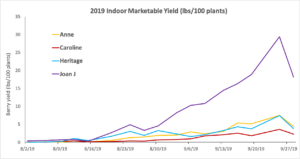
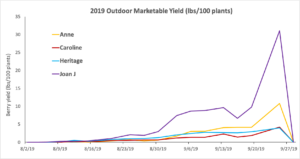
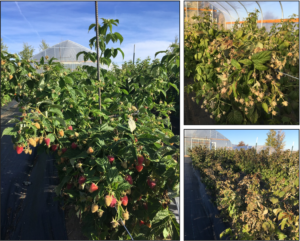
Table 6. First year raspberry data comparing four varieties grown outdoor (field) vs. indoor (high tunnel) in 2019. Raspberry picking started mid-Aug and ran until end of Sep/early Oct. Data is an average of four replicates.
|
Variety |
Marketable yield (lbs/ft) |
% Yield increase indoor |
% Cull (by weight) |
Average fruit size(g/berry) |
|||
|
|
Field |
Tunnel |
|
Field |
Tunnel |
Field |
Tunnel |
|
Anne |
0.17 b1 |
0.22 b |
33% |
20 |
13 |
4.1 ab |
4.3 a |
|
Caroline |
0.08 b |
0.10 b |
24% |
13 |
7 |
3.0 ab |
3.9 a |
|
Heritage |
0.12 b |
0.23 b |
80% |
10 |
8 |
2.3 b |
2.4 b |
|
Joan J |
0.46 a |
0.81 a |
79% |
23 |
10 |
4.8 a |
4.7 a |
1 Results in the same column followed by a different letter are significantly different at P < 0.05
Raspberry Trial, Second Year Results (2020)
New raspberry primocanes began to emerge in April 2020. Indoor cane growth started towards the beginning of April, while outdoor cane growth began towards the end of April. In early May, on two separated nights, temperatures outside fell below 20°F. After these events, there was significant dieback in the outdoor trial. The percentage of plant loss varied between varieties, with 79% loss of all Heritage plants, 32% loss of all Caroline plants, and 29% loss of all Anne and Joan J plants (Table 7). There was no new primocane growth later in the season from the raspberry plants that suffered dieback in May, indicating that the raspberry crowns actually died (Figure 16). There was not any plant loss in the high tunnel from the early May cold events (Table 7). The indoor plants were more mature and temperatures were about 2°F to 3°F higher in the high tunnel which may have accounted for the differences in plant survival.
Weekly vigor rankings were taken for all plots from mid-April through mid-July. The rankings were relative within each replication. In the outdoor planting, Joan J plants displayed the most vigor, while Heritage plants were the least vigorous. In the indoor planting, Caroline was the most vigorous and Anne was the least vigorous.
Table 7. Overwinter/early spring survival of raspberry plants. Percent survival calculated using plant totals from September 2019 and May 2020.
|
Variety |
Overwinter plant survival rate |
|
|
|
Outdoor |
Indoor |
|
Anne |
71% |
100% |
|
Caroline |
68% |
100% |
|
Heritage |
21% |
100% |
|
Joan J |
71% |
100% |
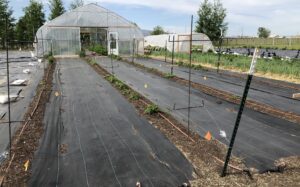
Due to plant loss and stunted growth, raspberry production was nearly non-existent for the outdoor planting in 2020. Total marketable yield averaged across all live plants was 0.1 lbs/ft outdoor, whereas indoor production averaged 1.3 lbs/ft over the growing season. Joan J raspberries started fruiting in the high tunnel in mid-August, but indoor production for the other three varieties did not start until early September (Figure 17). Raspberry production peaked in mid to late September for all of the varieties, and continued to produce well until mid-October. The extremely high raspberry harvest of September 20 came at the end of a 10-day gap in picking due to hazardous smoke conditions in the region. Raspberry production ended October 21 with freezing temperatures.
Percent cull by berry weight was higher for outdoor production (~30%) than indoor production (~5%), reflecting the very poor quality of outdoor fruit in 2020. Raspberry fruit size differed by variety and production system (Table 8). Average fruit size was greater under indoor production (2.6 g/berry) than outdoor production (1.7 g/berry). Joan J and Anne had overall larger fruit, followed by Caroline, and Heritage had significantly smaller berries.
Joan J stood out as the highest yielding raspberry variety, especially when grown in the high tunnel (Table 8). Total indoor marketable yield for Joan J was more than double the yield of Anne and Heritage, and 40% greater than Caroline. Fruit production came on late for Caroline, but produced nice, large berries later in the season. Anne had large, yellow berries and produced fairly well, but the fruit was more delicate and prone to being culled. Heritage is an heirloom variety and yielded lower than the other modern varieties due to its small fruit size and late maturity.

Table 8. Second year raspberry data comparing four varieties grown outdoor (field) vs. indoor (high tunnel) in 2020. First fruit was Aug 8 (indoor), and harvest ended on Oct 21. Data is an average of four replicates.
|
Variety |
Marketable yield (lbs/ft) |
% Yield increase indoor |
% Cull (by weight) |
Average fruit size (g/berry) |
|||
|
|
Field |
Tunnel |
|
Field |
Tunnel |
Field |
Tunnel |
|
Anne |
0.0 b1 |
1.0 b |
Very high |
0.2 b |
20.3 b |
1.3 ab |
2.9 a |
|
Caroline |
0.0 b |
1.3 b |
Very high |
0.0 b |
26.2 b |
0.8 ab |
3.0 a |
|
Heritage |
0.0 b |
0.8 b |
Very high |
0.0 b |
16.6 b |
- |
1.9 c |
|
Joan J |
0.2 a |
2.2 a |
>800% |
3.5 a |
44.6 a |
3.0 a |
2.6 b |
1 Results in the same column followed by a different letter are significantly different at P < 0.05
Raspberry Comparison Between Growing Seasons
It was expected that raspberry yield would increase in the second season due to the plants being more established, and that proved to be the case. Even with the outdoor crop failure, average raspberry yield was significantly greater in 2020 (0.73 lbs/ft) than in 2019 (0.27 lbs/ft). Average fruit size was lower in 2020 compared to 2019, suggesting increased yield was the result of increased berry numbers in 2020.
Indoor raspberry production was greater than outdoor production for both growing seasons. The outdoor crop failure in 2020 was unexpected, but revealed the importance of season extension in protecting sensitive plants from frost damage. Joan J consistently yielded the most in both years and in both production systems (Figure 18). Over the course of two growing seasons, Joan J produced roughly 600 lbs of fruit per 100 plants (200 row feet). Caroline was a very vegetative variety and fruit production occurred late in the season both years. In the first growing season, this was detrimental to Caroline’s yield, but Caroline’s performance improved in 2020 with the longer growing season and a larger berry size.

Daughter Trial Results - Raspberry
Limited data on raspberry harvest was collected from the daughter farms. One farm did not collect any data because the raspberry canes were outcompeted by perennial grasses and produced minimal fruit. The data that was collected from daughter farms was consistent with the mother trial results: Joan J was the highest yielding, followed by Anne, and then Caroline.
Fields Farm
The outdoor raspberries at Fields Farm were destroyed by deer, and did not produce a crop in 2019 or 2020. In 2019, Joan J started producing indoor on August 28, and fruited until Oct 8. Joan J produced 0.3 lb/ft total over the season. Caroline produced only a few berries during the 2019 season.
Golden Eagle Organics
In the first year, both outdoor and indoor production started August 17, 2019. Joan J and Anne produced ripe fruit indoor and outdoor starting August 17; Caroline produced Aug 17 indoor, but not until September 9 outdoor. Joan J had the highest yield compared to other varieties (0.4 lb/ft indoor) and produced until October 8. The raspberries at Golden Eagle were pruned for double cropping in early winter 2020 in order to harvest both floricane and primocane growth in the 2020 season. Floricane survival was very high indoors, but most floricanes in the outdoor planting died in the late winter/early spring 2020.
In the second year, Joan J and Anne were first ripe on July 10, 2020 in the high tunnel. The indoor planting of Caroline was first harvested on July 17. Harvest of all indoor raspberry varieties continued until September 2. Harvest for all three varieties outdoor ran from July 29 until August 21. Joan J was the highest yielding in the high tunnel and the field, followed by Anne, and then Caroline.
Overall Raspberry Variety Comparison
Descriptions of the four varieties and observations of their differences are outlined in Table 9. Joan J stood out as the highest yielding raspberry variety, especially grown indoor. Growers were fairly happy with the quality of Joan J's fruit, and the thornless canes made the plants much easier to manage. Over the two-year period, total marketable yield for Joan J raspberries grown indoors was 3 lbs/ft, or roughly 600 lbs/100 plants. The next closest variety in terms of yield was Caroline, which yielded half as much as Joan J over the two-year period (1.5 lbs/ft). Caroline remained vegetative most of the growing season and had a very small yield in the first year; however, once established, the plants produced very large berries, and the yield greatly improved in the second year. Anne had large, yellow berries and produced fairly well, but the fruit was more delicate and prone to being culled. Customers at the farmers market favored Anne, the yellow raspberry with big fruit size. Heritage is an heirloom variety and yielded lower than the other modern varieties due to its small fruit size and late maturity. There was not a clear winner in terms of taste for the berry varieties, but most taste testers liked the flavor of the outdoor raspberries more than the indoor berries.
Table 9. Description and key observations of the four primocane-bearing raspberry varieties evaluated in the trial.
|
Raspberry Variety |
Description and Observations |
|
Anne |
· Large fruit size · Earlier maturity · Good indoor yield · Blemishes/imperfections more obvious on yellow fruit · Fruit maturity harder to judge due to yellow color · Floppy canes that require more support |
|
Caroline |
· Large fruit size in second year · Later maturity · Heavy vegetative growth in 1st year with low fruit yield · Good indoor yield in 2nd year · Rigid, upright canes, but extensive vegetative growth indoor that requires management |
|
Heritage |
· Small fruit size · Firmer berry, holds up well to handling · Lower yield · Upright, sturdy canes |
|
Joan J |
· Medium fruit size · Earliest maturity · Highest yield · Thornless canes make handling much easier · Very floppy canes that require more support · Preferred variety of grower participants |
Pest Management
Insect, disease and wildlife pest pressure differed by growing season and by production system. Thrips were the main insect pressure in 2019. At the mother trial site, thrip pressure was very high in July of the 2019 growing season, which caused bronzing and deformation of the strawberries. All of the strawberry and raspberry plots were sprayed once with Mycotrol (1quart/ac) in mid-July, an organic insecticide (active ingredient Beauveria bassiana). Thrip pressure was higher in the high tunnel than the open field. Thrip pressure was also very high at one of the daughter trial sites in 2019, and caused similar bronzing in strawberries. One daughter trial site struggled with earwigs in 2019, which caused worse damage for indoor strawberries than outdoor. Two daughter trial sites had significant occurrences of common leaf spot in their indoor strawberries later in the season. The farm with the highest disease incidence was using overhead irrigation and did not have proper ventilation in their high tunnel. The disease pressure lessened in 2020 when they installed roll-up sides in their high tunnel. The second farm also did not have proper ventilation in their high tunnel, and believed that was the cause of the leaf spot. One farm suffered significant damage to their outdoor strawberry and raspberry plantings from deer, which continued into the second growing season.
Spider mites were the main insect pest in 2020, and was worse in the high tunnels. At the mother trial site, spider mites were observed in the indoor raspberry planting in late June 2020. They spread significantly in July leading to some defoliation. There was minimal spider mite pressure in the outdoor planting. Cinnerate was applied in late July and early August at a rate of 32 oz/100 gallons. Spider mite pressure seemed somewhat reduced after these applications. During the 2020 growing season, rodent and bird damage to strawberry fruit was notable at the mother trial site, particularly in the high tunnel. Distinguishing between rodent and bird damage was not always possible, but rodent damage seemed more apparent early in the growing season. Bird damage started a bit later and remained more constant over the growing season. No steps were taken to reduce the fruit damage due to rodent and bird pressure, but it is recommended to use netting to keep birds out of commercial strawberry fields. For the daughter trial sites, pest pressure was fairly similar to the previous growing season. One farm used netting to protect their outdoor berry plantings and found that it was helpful, but made picking more time consuming.
Economic Comparison - High Tunnel vs Open Field
The use of high tunnels for vegetable and flower production is common practice in central Oregon. Growers are able to grow multiple rotations of high value annual crops in their high tunnels each season, and therefore, wanted to evaluate whether it was worthwhile to dedicate high tunnel space to a single crop for multiple years. There are many different types of high tunnels that vary in cost and ease of construction, ranging from do-it-yourself caterpillar tunnels, to commercial high tunnel kits. The high tunnels used to grow berries in this study covered a wide range: do-it-yourself caterpillar tunnels; commercial caterpillar tunnels; quonset-style commercial kits; and gothic-style commercial kits.
Strawberry High Tunnel
At the main research site, strawberries were grown in a DIY caterpillar tunnel constructed out of PVC with wooden endwalls and doors (Figure 19). The high tunnel was built per the specifications from Utah State University Extension ((https://extension.usu.edu/productionhort/high-tunnel/construct). Due to high winds, additional materials were purchased to reinforce the high tunnel and secure it to concrete blocks in the ground. Estimated cost for a 14x50ft DIY high tunnel built in this style is ~$700 in materials ($1/sq ft). A 14x50 ft high tunnel would accommodate 300 strawberry plants, planted in three beds with double rows.
Cumulative strawberry production for the 2019 and 2020 growing seasons was used in order to compare gross income for indoor and outdoor strawberry production (Table 10). Yield results were averaged across varieties to present results for a mixed-variety farm; but results are also shown for growing only Evie 2, the highest yielding strawberry. Based on pint weights and a price of $4/pint, estimated gross income over two growing seasons was $1,296/100 plants grown outdoor, and $1,956/100 plants grown indoor (Table 10). A 14x50ft high tunnel full of strawberries (3 beds with 100 plants each) would add ~$2,000 to a grower's income over two years compared to the same bed space of strawberries outdoors. Based on these figures, it seems that indoor strawberry production is a worthwhile enterprise. This is only a gross income estimate, and does not take into account the labor required to manage and pick the strawberries.

Table 10. Total marketable strawberry yield, estimated pint count, and projected gross income for 100 strawberry plants over two growing seasons. Unit of measurement represents 50 bed feet of crop (double row). Results are based on 2019-2020 data from main research site in Alfalfa, OR.
|
|
Outdoor, average for all varieties |
Indoor, average for all varieties |
Outdoor, Evie 2 only |
Indoor, Evie 2 only |
|
Total yield in 2 years |
224 lbs/100 plants |
318 lbs/100 plants |
284 lbs/100 plants |
392 lbs/100 plants |
|
Total estimated pints in 2 years |
324 pints |
489 pints |
394 pints |
576 pints |
|
Estimated gross income over 2 years @ $4/pint |
$1,296 |
$1,956 |
$1,576 |
$2,304 |
|
Income difference indoor |
|
$660/100 plants |
|
$728/100 plants |
Raspberry High Tunnel
The raspberries at the main research site were grown in a gothic-style commercial high tunnel that came as a kit, measuring 30x45ft (Figure 20). The roll-up sides and barn-style doors on the end walls added to the cost; total estimated cost for materials was ~$4,500, or $3.30/ft. The commercial kit can be erected on your own, but a contractor was hired to help with the build. The 30-ft wide high tunnel accommodated four rows of raspberry plants.
As with strawberries, cumulative raspberry production for the 2019 and 2020 growing seasons was used in order to compare gross income for indoor and outdoor berry production (Table 11). Yield results were averaged across varieties to present results for a mixed-variety farm; but results are also shown for growing only Joan J, the highest yielding raspberry. Based on half-pint weights and a price of $4/half pint, estimated gross income over two growing seasons was $488/100 plants grown outdoor, and $3,456/100 plants grown indoor. The estimated gross income for growing only Joan J was much higher (Table 11). A 30x 50ft high tunnel with four rows of raspberries would accommodate 200 row feet of crop, and for mixed varieties would add ~$3,000 to a grower's income over two years compared to the same bed space of raspberries outdoors. If growing only Joan J, 200 row feet of raspberries in a high tunnel would add ~$5,000 to a grower's income compared to growing Joan J outdoors. It is important to remember these comparisons reflect the outdoor plant loss suffered in spring 2020. Based on these figures and considering that raspberry canes can last for more than 10 years, it seems that indoor raspberry production is a worthwhile enterprise that would pay for itself after several seasons. However, this gross estimate does not include labor costs, and picking raspberries is very labor-intensive.
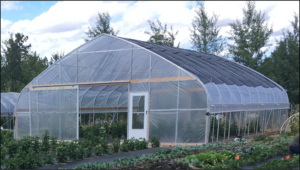
Table 11. Total marketable raspberry yield, estimated half-pint count, and projected gross income for 100 raspberry plants over two growing seasons. Unit of measurement represents 200-row feet of crop. Results are based on 2019-2020 data from the main research site in Alfalfa, OR.
|
|
Outdoor, average for all varieties |
Indoor, average for all varieties |
Outdoor, Joan J only |
Indoor, Joan J only |
|
Total yield in 2 years |
50 lbs/100 plants |
337 lbs/100 plants |
126 lbs/100 plants |
609 lbs/100 plants |
|
Total estimated half pints in 2 years |
122 half pints |
864 half pints |
315 half pints |
1,562 half pints |
|
Estimated gross income over 2 years @ $4/half pint |
$488 |
$3,456 |
$1,260 |
$6,248 |
|
Income difference indoor |
|
$2,968/100 plants |
|
$4,988/100 plants |
Conclusions by Project Objectives
Objective 1. To evaluate raspberry and strawberry production in both protected and unprotected culture systems in Central OR, including berry yield and quality, in order to help growers choose the most successful production systems.
Overall, berry yields improved in the high tunnels (protected culture) vs the open field (unprotected culture). Yield differences between production systems were more pronounced in the second season than the first, likely because the plants were already established and able to take advantage of a longer growing season inside the high tunnels. Both strawberry and raspberry fruit was larger indoor than outdoor. Larger fruit equates to greater yields, and fewer fruit is needed to fill a pint, which is an advantage for the grower. The impact of production system on berry quality was not as clear. For strawberries, percent cull was greater outdoor in 2019, but was greater indoor in 2020. For raspberries, percent cull was higher outdoor than indoor. Some taste test participants found the outdoor berries to have better flavor, but other participants preferred the flavor of indoor berries.
Unanimously, grower participants indicated that strawberries should be grown in a high tunnel for production in central Oregon to be worthwhile. In addition, row cover should be used for additional frost protection late winter/early spring in order to achieve the earliest production possible.
Results from this study indicate that some form of frost protection/season extension is needed to have a successful raspberry crop in Alfalfa, OR. As reported, the outdoor crop failed in the second growing season due to early spring freezes killing newly emerged growth, and the indoor crop clearly benefitted from protection of the high tunnel. It may have been possible to use low tunnels or row cover to protect early shoot emergence outdoors, but this was not trialed in our study. It is important to note that temperature swings in Alfalfa can be more extreme than other growing regions in central Oregon, and other farms in Deschutes County did not experience outdoor crop failure.
Objective 2. To compare multiple cultivars of raspberry and strawberry for suitability to Central OR, including adaptability, berry yield and quality, in order to help growers make cultivar selections for production success.
Strawberries
Evie 2 was the highest yielding strawberry and started producing quite early, making it a good choice for central Oregon production. However, berry quality (flavor and handling) was lower than other varieties. Mara des Bois came out of the winter with greater vigor than the other strawberry varieties and started producing fruit earlier, making it a good choice for outdoor production. While many people liked the flavor of Maras des Bois, its small size made harvest too time consuming to be profitable unless the grower was receiving a premium price. Although yielding a little lower and maturing a little later, Seascape is a good option for strawberry production in central Oregon, and has a good flavor and texture profile. Albion fruit production came on much later and underperformed in terms of yield in our trial. Based on our two-year study, the central Oregon strawberry season peaks from late July through September, which may be later than expected by many consumers.
Raspberries
Joan J was the clear winner for both indoor and outdoor raspberry production across the trial years; fruit production came on the earliest and overall yield was the highest. Berry yield of Joan J over the two-year growing season was more than double of the other three varieties tested in the trial. Additional considerations for Joan J are that it is thornless (benefit), but the canes are not very rigid and are difficult to keep upright in a trellis (drawback). Seasonal maturity of Anne would suit central Oregon, and it offers a yellow berry for customers. While Anne's fruit is nice and large, the light-colored fruit was prone to being culled easily. Caroline and Heritage had more upright growth habits that were easier to manage with a trellis, but they were both late-maturing and therefore not ideal options for central Oregon where early fall frosts are possible.
Objective 3. To perform economic evaluation of both protected and unprotected berry production in Central OR, and determine whether protected culture is a justified investment.
Berry yields did improve under protected culture in this study, but depending on the cost of the high tunnel and space on the farm, growers would need to decide whether it is worth the investment. To optimize berry production, the entire high tunnel should be dedicated to one berry crop so that temperature and irrigation are tailored to the needs of the specific crop. It is more likely that growers will dedicate a small, less expensive high tunnel (e.g., DIY caterpillar tunnel) to berry production, rather than a tall and large expensive high tunnel (e.g., gothic style). Based on the high tunnels used in this study, strawberry production can be optimized in a small high tunnel, and is likely worth the investment. It also appears that if a grower has the labor capacity to grow raspberries, then growing berries in a high tunnel in central Oregon would pay for itself in a few years. In our study, there was a very significant economic difference between the growing systems due to the extreme plant loss of outdoor raspberries. Other growers in the study also suffered losses to their outdoor raspberries from wildlife or pruning winter damage, indicating that producing raspberries indoor would lead to more consistent results in central Oregon. Utah State University Extension provides DIY plans for building a high tunnel for taller crops (https://extension.usu.edu/productionhort/high-tunnel/construct), which could be a viable option for those wanting to grow raspberries in a high tunnel without the cost of a commercial kit.
Objective 4. To observe differences in pest management challenges in protected and unprotected culture.
Overall, pest pressure tended to be higher in the high tunnel than the open field. Thrips, mites, disease, and rodent damage were worse indoor; while bird and deer pressure were worse outdoor.
Research Outcomes
Education and Outreach
Participation Summary:
Consultations
Consultations were conducted individually with each of the six farms (10 farmers) involved in the research project. Clare Sullivan (PI) consulted on what berry crop type would best suit their operation, helped them choose berry cultivars of interest, and determined nutrient application rates based on their soil tests. In addition to the farms in the study, the PI consulted with six local farms between 2019-2021 as they made decisions on berry plantings.
Field Tours
In November 2018, the PI organized a tour of commercial berry farms in the Willamette Valley, OR for the farmer cooperators involved in the research project. The PI and five farmers visited two commercial berry operations that grew raspberries and strawberries in high tunnels and in the field. One operation was mid-scale and used organic practices, and the other was larger-scale conventional The group received educational information from the two farm managers we visited, including perspective on planting and maintenance, variety selection, considerations for field and high tunnel production, and marketing information.
During the summer of 2019, the PI organized three field tours for the seven cooperating farms. The group toured Golden Eagle Organics in Bend, Windflower Farm in Alfalfa (main research site), and Boundless Farmstead in Alfalfa. At Golden Eagle Organics, farmers observed raspberry and strawberry production in a gothic-style high tunnel, a caterpillar tunnel, and the open field; and learned about a small-scale fertigation system. At Windflower Farm, farmers observed raspberry and strawberry production in gothic-style and low-cost PVC high tunnels, and the open field; and learned about three different raspberry trellising systems. At Boundless Farmstead, farmers observed strawberry production in a quonset-style high tunnel and the open field, and saw a side-by-side comparison of first and second year strawberry plantings.
Due to restrictions of CoVid-19, a virtual field tour of the research site was held during the summer of 2020. The PI created a video update of the trial and posted it on the local Extension website (https://extension.oregonstate.edu/smallfarms/central).
Workshops/Field Days
In February 2019, Tanya Murray from Oregon Tilth gave a "Cost of Production" Workshop at the OSU Extension office in Redmond (Central Oregon). Three of the cooperating farmers involved in the berry project attended the workshops and learned labor tracking skills and cost of production skills to implement on their farms.
A hybrid online/in-person cost of production program, 'Know Your Costs to Grow', was held January 2020 in Central Oregon, and three of the berry project cooperating farms are signed up for the program. This was continuing education from 2019 on tracking the costs of producing different crops, and the intention was for berry growers to use this training to track production costs of raspberries and strawberries. The program ran the entire 2020 growing season and conclude with a follow-up workshop end of 2020.
In March 2019, the PI hosted a Berry Production Workshop in Redmond, OR, taught by the OSU Berry Specialist Dr. Bernadine Strik. The workshop was open to the public and was an in-depth overview of raspberry and strawberry production, including: berry type and morphology; berry establishment and maintenance; raspberry pruning and trellising; and berry nutrient management. Attendees reported significant knowledge gained from the workshop, and berry project cooperating farmers indicated that it set them up very well for the season.
Also in March 2019, the PI hosted an advanced high tunnel workshop taught by two Utah State University Researchers. The workshop was open to the public and the information was extremely relevant to high desert production systems. Brent Black (USU Berry Specialist) presented specifically on high tunnel raspberry and strawberry production.
In September 2019, the PI hosted a Berry Field Day at the main research site (Windflower Farm). The field day was open to the public and the PI shared observations from the berry research trial, including: land prep; planting techniques; plant maintenance; pest management; trellis systems; high tunnel construction; variety differences; and production system differences.
A virtual field day/workshop on "high tunnel raspberry production" was held in April 2020, in collaboration with Javier Fernandez-Salvador of OSU Extension. This educational event was an overview of raspberry production, and included specifics on using high tunnels for raspberry production int eh high desert. The virtual field day was attended by 19 participants, and included results from the first year of the trial.
On-Farm Demonstrations
The PI hosted a low-cost high tunnel construction demonstration at Windflower Farm (main research site) in April 2019. Design plans from Utah State University Researchers were used to build a 14 x 45ft high tunnel out of PVC, and the public was invited to take part in the high tunnel construction. A second demonstration was hosted at Windflower Farm in May 2019 to teach proper planting techniques for strawberries and raspberries.
Taste Testing Events
One of the objectives of this research is to evaluate the quality of the berries, not just the quantity produced. The PI hosted three different taste testing events at the end of the 2019 growing season and recorded participants' opinions on berry flavor and texture. Eight raspberry and strawberry treatments were compared; four varieties and two production systems (indoor vs. outdoor). One taste testing event was for the cooperating farmers, one was open to the public at Windflower Farm, and one was for buyers. It was impractical to host a tasting event for buyers, therefore the PI brought berries to them; the berries were evaluated for their quality by three chefs/bakers and one wholesale buyer.
Published Report and Press Articles
First and second year results of the berry research project were published as two separate reports in the 2019 & 2020 Central Oregon Agriculture and Extension Center Annual Report (https://agsci.oregonstate.edu/coarec/coarc-annual-reports). A University press article was also written about the project: https://ourimpact.oregonstate.edu/story/high-tunnels-show-growing-berries-central-oregon-profit-possibility
Talks and Presentations
The PI presented information from the first year of the berry project at the OSU Small Farms Conference in Corvallis, OR in February 2020. The presentation was attended by 27 farmers and agricultural professionals from the PNW region. In April 2020, the PI hosted a virtual "Central Oregon Berry Production Workshop" that was attended by 17 farmers from the high desert region. The workshop included first year results from the berry project and berry production overview information from Dr. Strik's workshop in 2019.
Extension publications will be written based on the two year project in the winter of 2021-2022.
Education and Outreach Outcomes
Gained knowledge of establishing strawberries under plastic mulch, both in high tunnels and in the field
Learned the pros and cons of growing raspberries using fabric row cover
Awareness of the considerations for choosing berry varieties related to marketing
Knowledge about the different types of raspberries and strawberries, including their morphology
Knowledge of how to establish, prune, and train a raspberry planting
Knowledge of what is required to establish and manage a strawberry planting
Knowledge of the nutrient management requirements for berry crops
Awareness of the pest pressure for berry production in Central Oregon (both in high tunnel and open field)
Performance differences of growing berries in high tunnels vs. the open field
